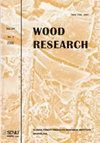EFFECT OF ANATOMICAL STRUCTURE ON DIMENSIONAL STABILITY OF LOW MOLECULAR WEIGHT PHENOL-FORMALDEHYDE IMPREGNATED WOOD
IF 1
4区 农林科学
Q3 MATERIALS SCIENCE, PAPER & WOOD
引用次数: 1
Abstract
This research deals with low molecular weight-phenol formaldehyde (LMW–PF) impregnation on sepetir (Sindora spp), nyatoh (Palaquium spp.), and pisang putih (Mezzettia spp.) woods to determine the effect of different anatomical structure on weight percent gain and dimensional stability improvement. The wood samples were impregnated using LMW–PF solutions with 7, 8, 9, 10, and 11% of concentrations (w/w), vacuum-pressured (–98 kPa, 15 min, 350 kPa, 4 h), and re-immersed in 80°C for 3 h. According to the findings, LMW–PF impregnation reduced coefficient of swelling by 9.64–29.95%, and increased anti-swelling efficiency by 12.24–29.91%. Additionally, the water absorption and thickness swelling reduced by 2.43–38.75% and 15.94–34.21%, respectively, indicating the improvement of dimensional stability. Microscopy and NIR analysis revealed the presence and reaction of LMW–PF within porous wood matrix. The effect of diverse anatomical structures caused complexity on LMW–PF impregnation. Sepetir-treated wood with fewer anatomical barriers resulted in better dimensional stability improvement than others.解剖结构对低分子量酚醛浸渍木材尺寸稳定性的影响
本研究对低分子量酚醛树脂(LMW–PF)在sepetir(Sindora spp)、nyatoh(Palaquium spp.)和pisang putih(Mezzettia spp.)木材上的浸渍进行了研究,以确定不同解剖结构对增重率和尺寸稳定性改善的影响。使用浓度为7%、8%、9%、10%和11%(w/w)的LMW–PF溶液浸渍木材样品,真空加压(–98 kPa,15分钟,350 kPa,4小时),并在80°C中重新浸渍3小时。根据研究结果,LMW–PF-浸渍使膨胀系数降低了9.64–29.95%,抗膨胀效率提高了12.24–29.91%。此外,吸水率和厚度膨胀率分别降低了2.43–38.75%和15.94–34.21%,表明尺寸稳定性有所提高。显微镜和近红外分析揭示了LMW–PF在多孔木材基质中的存在和反应。不同解剖结构的影响导致LMW–PF浸渍的复杂性。Sepetir处理的木材具有较少的解剖屏障,比其他木材更好地提高了尺寸稳定性。
本文章由计算机程序翻译,如有差异,请以英文原文为准。
求助全文
约1分钟内获得全文
求助全文
来源期刊

Wood Research
工程技术-材料科学:纸与木材
CiteScore
2.40
自引率
15.40%
发文量
81
审稿时长
5.4 months
期刊介绍:
Wood Research publishes original papers aimed at recent advances in all branches of wood science (biology, chemistry, wood physics and mechanics, mechanical and chemical processing etc.). Submission of the manuscript implies that it has not been published before and it is not under consideration for publication elsewhere.
 求助内容:
求助内容: 应助结果提醒方式:
应助结果提醒方式:


